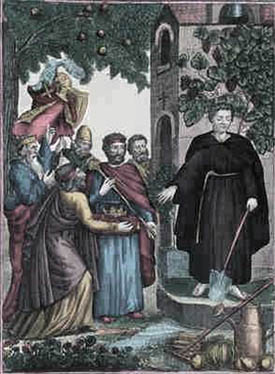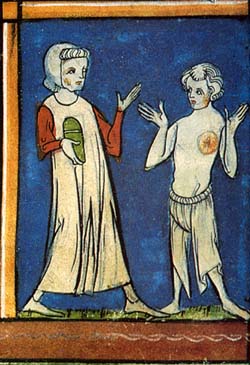 |
The Saint of the Day
St. Fiacre, September 1
Prof. Plinio Corrêa de Oliveira
Biographical selection:
St. Fiacre was born at the beginning of the 7th century into an illustrious Irish family. The Scots affirm that he was the son of one of their kings who was raised with his brothers by St. Conon, Bishop of Iona.

St. Fiacre, patron saint of gardeners
|
As a young man, Fiacre left his parents and family to serve God in solitude. He went to France, seeking St. Faro, Bishop of Meaux, and asked him for a place where he could live a solitary life away from the world. The Bishop was filled with joy upon hearing this request.
He told Fiacre: “Not far from here is a forest that is my patrimony and that the people call Breuil. It is very quiet and isolated.” The two saints traveled there together and chose a place for Fiacre, and the Bishop gave him everything he needed.
St. Fiacre cleared the woods, built a chapel in honor of the Holy Virgin, and also a house beside it where he lived and received guests. Later he built a small hospital where he would administer to the sick and the poor, and many times he cured them by virtue of his prayers.
He never allowed women to enter his hermitage. This was an inviolable tradition in the Irish monasteries. He extended the restriction to include the chapel, and applied this rule as long as he lived. Still today, out of respect for his memory, women do not enter either his hermitage or the chapel where he was buried. Even Anne of Austria, the Queen of France, who made a pilgrimage to the shrine in thanksgiving for a favor received, remained outside the door of his chapel.
The Scots recount that around this time the throne of Scotland became vacant, and deputies of that country traveled to Breuil to ask St. Fiacre to return and be crowned king. He humbly but firmly refused.
The saint died on August 30, 670, and was buried in the chapel he had built. Countless miracles followed his death and made the name of Fiacre famous. In France gardeners honor him as their patron saint. For, in fact, by praying in his chapel and working in his garden, St. Fiacre earned a throne in Heaven. His feast day is commemorated on September 1st.
Comments of Prof. Plinio:
I don’t know what is more significant, the beauty of the various individual events in the life of St. Fiacre or the ensemble of facts that unite to exude the perfume of legend around him.
On one hand, from the perspective of the beauty of the individual events, nothing is more beautiful than to imagine a saint who is a son of a king and travels to a far-away country to take up his abode in a forest in order to flee the royal pomp. He seeks another saint, finds him, and then the two travel together to the forest to choose a place for him to live the rest of his life. And then you have this prince who lives as a hermit.
After living this solitary life for a long time, an occasion presents itself for him to return to his noble life and ascend to the throne. At times he might have felt nostalgia for the life he had left behind. But he refuses this second opportunity and dies as a very humble gardener, as the guardian of the hospital he had built in the forest of Breuil.
I think that perhaps the second refusal is even more beautiful than the first. Very often, when a young man leaves a certain life he is accustomed to, he doesn’t fully realize what he is leaving. He doesn’t miss it yet, and he doesn’t realize yet the bitterness of the life he will assume. He only sees the new life in a golden light.
It is easy to see how, for a prince who is accustomed to a royal palace and has become a bit tired of the royal pomp, the idea of living as a hermit in a forest can be very seductive, very attractive. But after living there for a while, after realizing how hard it is to not have the comforts of a prince, after a while when the forest has lost its poesy and is showing its prosaic side – the fight against vermin, cold, heat, etc. – then he has the opportunity to evaluate objectively the sacrifice he made. So, to refuse the royal life for the second time, when a concrete occasion presented itself for him to rise to an even higher position than his first one, is nobler than the first refusal.
An impious Englishman of the 19th century used to tell about a visit he made to a Carthusian monastery in Spain. He was impressed with the marvelous view one could admire from the monastery seat. “What a beautiful place!” he exclaimed. The Carthusian monk who was accompanying him replied: “Beautiful if you are visiting, terrible if you are staying.”
You can see that it is an impious story, with anti-religious hues. But there is something true in it. Many situations that are beautiful upon entering become very difficult to endure after staying a while. Well, here you have St. Fiacre who remained faithful his whole life to the first resolution made in his youth. It is the beauty of fidelity, of continuity, that deserves our admiration.
On the other hand, from the perspective of his whole life, you can imagine the silence of the forest of Breuil in the Diocese of Meaux. Day after day, night after night, no one passes by, there is only the saint who prays, and works - taming nature. Little by little he conquers the wild terrain of the forest. He is accomplishing in a small proportion what the Church does in great proportion: she civilizes, she brings culture to the places she comes to.

Curing the sick who come to him
|
And so he planted and cultivated the ground around his hermitage, taking care of each one of his plants and flowers and giving glory to God for them. Once in a while, a traveler would come by and ask to spend the night. Perhaps he is troubled, he tells his problems to the saint, receives a good counsel from him, and then goes away. In the next town the traveler reports that he met a saintly hermit.
Another time it is a sick man who comes to him and is cured. The cured man tells others, the fame of the saint spreads, other sick and poor men begin to find their way to him. And so he builds a small hospital to administer to them. The reports of his sanctity continue to spread, and a fragrance pleasing to God fills the whole area and rises up to Heaven. It is the perfume of Jesus Christ that conquers Breuil and extends through Meaux. This is often the history of the saints in the Middle Ages, and it is the marvelous scenario you find in the life of St. Fiacre.
Veneration for St. Fiacre spread throughout France. In the 19th century there was a St. Fiacre Hotel in Paris. Near it was the place where the rental carriages of the time, drawn by horses, used to be parked awaiting customers. From this, that kind of vehicle came to be called fiacre. And St. Fiacre, who was already the patron of the gardeners of France, also became the patron of the cab drivers of Paris. And still today people call upon the name of St. Fiacre.
This is the beauty of the lives of the saints; this is the marvelous aspect of the grace that perfumes History and gives rest to our souls after a weary day of battles and disappointments. Reading a life like this, we receive a fresh breeze of repose and peace that makes us understand a little of the perfume of the Middle Ages. And also we sense a little of what will be the perfume of the Reign of Mary, when the things that characterize the Revolution will be destroyed, and a new Christendom will be built.


  | | Prof. Plinio Corrêa de Oliveira | |
The Saint of the Day features highlights from the lives of saints based on comments made by the late Prof. Plinio Corrêa de Oliveira. Following the example of St. John Bosco who used to make similar talks for the boys of his College, each evening it was Prof. Plinio’s custom to make a short commentary on the lives of the next day’s saint in a meeting for youth in order to encourage them in the practice of virtue and love for the Catholic Church. TIA thought that its readers could profit from these valuable commentaries.
The texts of both the biographical data and the comments come from personal notes taken by Atila S. Guimarães from 1964 to 1995. Given the fact that the source is a personal notebook, it is possible that at times the biographic notes transcribed here will not rigorously follow the original text read by Prof. Plinio. The commentaries have also been adapted and translated for TIA’s site.
|
Saint of the Day | Home | Books | CDs | Search | Contact Us | Donate

© 2002- Tradition in Action, Inc. All Rights Reserved
|
 |

|